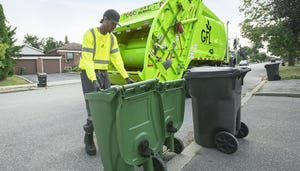Gearing Up the Gas
January 1, 2004
Mario Iacoboni, Josephine Chow and Ed Wheless
IT'S GENERALLY DIFFICULT to get a landfill gas energy (LFGE) project going without a good supply of landfill gas (LFG). However, the County Sanitation Districts of Los Angeles County (CSDLAC), Whittier, Calif., has proved otherwise — by successfully generating power using low Btu landfill gas at the Calabasas Landfill.
Located in Agoura, Calif., the 416-acre Calabasas Landfill was initially thought be an ideal site to operate microturbines to generate power based on its waste intake and LFG collection and irrigation systems. However, operators soon discovered that implementing microturbine power plant would be challenging because of the sites low-methane LFG. Nevertheless, by carefully collecting and handling the gas, the CSDLAC has created a cost-effective power plant that generates enough electricity to run the onsite LFG collection system blowers.
A Basis for Burning
The CSDLAC is a confederation of 25 Special Districts serving approximately 5.4 million people in Los Angeles County, which covers 800 square miles including 78 cities and unincorporated territories. This requires the confederation to research, plan, design, construct, and operate and maintain the area's wastewater treatment and solid waste disposal facilities. In accomplishing these tasks, the CSDLAC has long been considered a leader in implementing projects that recover and use biogas and biomass byproducts from waste.
For example, in 1938, gas from wastewater sludge digesters was used to fuel internal combustion engines to generate all the power requirements at that time for the CSDLAC's largest treatment facility. Gas generated at the confederation's landfills also has been tapped for power generation since 1983.
The CSDLAC views the use of biogas and solid waste as a resource that allows it to manage energy resources, conserve fossil fuels, reduce air emissions and enjoy economic benefits.
The existing facilities currently produce about 125 megawatts (MW) of electrical power. With the addition of an 8-MW internal combustion engine plant, which will be completed in early 2005, the total power that will be produced will be 133 MW (22 MW generated from digester gas, 71 MW from LFG, and 40 MW from solid waste. And with the ever-changing energy market in California, which has been spurred by the failure of deregulation, the CSDLAC's renewable resources are expected to be competitive with conventional power generation technologies.
Energy Resources
The Calabasas Landfill, which has been active since 1961, has an estimated 21 million tons of refuse in place and currently accepts 1,100 tons of refuse per day. The LFG collection system consists of 650 vertical extraction wells and more than 70,000 linear feet of horizontal trenches. Approximately 6,000 standard cubic feet per minute (scfm) of LFG with a 25 percent methane content is collected and flared at the landfill.
The CSDLAC first began field-testing microturbines to generate power with a 30-kilowatt (kW) Capstone microturbine fueled by biogas at the Palmdale Water Reclamation Plant and the Puente Hills Landfill in 2000. This was the first site that Capstone attempted to operate its microturbine generator exclusively on LFG. The tests indicated that microturbines could successfully be run using biogas and that removing moisture from the gas going into the microturbine was critical. Experiments using desiccants, coalescing filters and deliquescent filters failed to yield consistent operations. Thus, operators were encouraged to search for a more consistent moisture removal method, which led them to select a packaged chiller.
By early 2002, after a severe energy crisis in California, the South Coast Air Quality Management District (SCAQMD), the local air quality agency, awarded the CSDLAC with 10 30-kW microturbines as part of its microturbine emergency power program. Because the Calabasas Landfill has a peak load of 320 kW for the LFG collection and irrigation systems, the microturbines were a good match for the onsite power demand. However, the CSDLAC had to resolve how to implement a project at a landfill with poor-quality gas.
LFG Limitations
The overall LFG quality for the Calabasas Landfill is approximately 25 percent methane — below the lowest limit for microturbine performance — 350 Btu per standard cubic foot (Btu/scf) or approximately 35 percent methane.
To solve this problem, a select area of the landfill that had historically generated higher methane levels was targeted for selective gas collection, and a dedicated system was developed to deliver the higher quality gas to the power plant. SCS Energy, Long Beach, Calif., designed and installed the microturbine power plant.
An above-grade LFG header was connected to seven existing wells that were producing more than 40 percent methane to supply fuel to the microturbine power plant. At each well, the header was interconnected with the existing header/laterals, and valves were included to allow vacuum to be applied to the wells from the new header. A check valve was placed at the end of the new header to operate the new header without disrupting the existing LFG collection system.
Now, when the microturbine power plant is operating, the check valve is closed and all available LFG is directed to the plant. If the plant is shut down, the valve opens and LFG is redirected to the flare station through the original header. A bypass line, added to the pretreatment skid, routes excess LFG to the flare station. At full or partial load, the same amount of LFG is extracted from the wells through the dedicated header. The plant uses approximately 150 to 180 scfm of LFG, depending on the methane content, to produce 300 gross kW of electricity.
Shedding the Unwanted
The plant also is equipped with a fuel pretreatment system that removes moisture and siloxanes before LFG enters the turbines.
Siloxanes form when products such as deodorant, cosmetics and lubricants are discarded in landfills and breakdown to a gaseous compound containing methane, silica and oxygen. Combusting LFG containing siloxanes produces a fine silica powder that can form harmful deposits on interior machine surfaces and may erode microturbine components. Thus, siloxanes should be removed prior to introducing gas into microturbines to reduce fouling the recuperator and possibly eroding the turbine nozzle vanes.
The moisture and siloxane removal system includes a compressor, a chiller and two carbon vessels in series. The compressor is an oil-flooded sliding vane type, which boosts the gas pressure from -30 inches water column (w.c.) to approximately 90 pounds per square inch gauge (psig). A packaged chiller is used with a gas-to-water heat exchanger to cool the LFG to 40 degrees Fahrenheit, and the chilled gas is reheated with the compressed LFG to a minimum of 20 degrees above the dew point. The carbon vessels containing activated carbon are for final polishing and siloxane removal.
Siloxane concentrations at various landfills generally range between 0.2 parts per million by volume (ppmv) to about 10 ppmv. Based on CSDLAC's samples of exhaust from the carbon columns, siloxane concentrations that average 0.3 ppmv are reduced to 0.2 ppmv by the gas chiller and carbon columns.
However, the low concentration has made it difficult for operators to reliably measure the siloxane concentrations because laboratories have had difficulty detecting siloxane polymers below 0.2 ppmv. The CSDLAC currently is investigating different methods and laboratories to see if lower detection levels are possible.
In the meantime, two types of activated carbon, with similar adsoprtion capacities, have been tested in the carbon vessels to remove siloxanes: graphite-based activated carbon and coconut shell-based activated carbon. Testing different media helps to determine which media increases the time between carbon material change outs and ultimately results in the lowest operating costs.
Overall, the pretreatment system has been able to consistently deliver clean and dry gas to the microturbines, resulting in a very high level of plant availability. The plant also has electrical switchgear and utility equipment necessary to interconnect with Southern California Edison's (SCE) utility grid system. When the microturbine power plant is not operating, standby power is supplied by SCE. A plant computer with a touch screen interface and remote access controls the power plant.
To reduce emissions from the microturbine exhaust, Capstone also has replaced the combustion system injectors on all 10 microturbines. The Calabasas Microturbine Power Plant initially was issued a construction permit from the SCAQMD that required it to meet certain emissions requirements. But because the landfill had to slightly modify its combustion system to optimize it for natural gas, the exhaust of the microturbines exceeded the allowable CO level. The new injectors have brought the CO emissions level to below the permitted level.
Changing Controls
Capstone's microturbine monitoring software (CRMS) originally was developed to regulate the microturbines onsite or remotely using a central computer with a touch screen. The original design used a “master-slave” network configuration to control the turbines. In other words, one turbine was set up as the “master” to communicate with nine other “slaves” through a Capstone Modbus Translator. However, the original control system did not allow the microturbines to operate independently to match power production. So to facilitate load following, CSDLAC upgraded the control system:
A new control system was connected to the microturbines through a Modbus network and translator located at each turbine. Now, the translator passes system queries and control commands to each microturbine individually.
The system currently includes a hardwired control relay located in the rear control panel of each turbine. This allows the system to stop the turbines immediately in case of a system shutdown.
A keyed disconnect was installed to prevent the turbine from operating when the key is removed. This allows service personnel to lockout/tag-out each turbine for servicing.
The programmable logic controller (PLC) was upgraded to monitor power consumption for the facility and determine the number of turbines required to meet power demand. When facility power consumption drops (at night and on weekends), the PLC shuts down a few turbines to avoid significant (uncompensated) power export. Shutdowns are based on turbine runtime hours, with the turbine having the greatest runtime hours being shutdown first. If the power consumption increases, the PLC recalculates the required number of turbines and restarts them. The upgrade is designed to reduce the wear and tear on the microturbines to minimize maintenance costs.
Low Gas Pays Off
Despite the challenges faced in operating the microturbine power plant at the Calabasas Landfill, it has been operating successfully since October 2002. The availability of the plant is 97 percent. CSDLAC has noted the pretreatment system, in particular, minimized interruptions to the operation.
Total project cost for the power plant including the control system upgrade and a two-year extended warranty from Capstone was $441,500. SCS Energy secured $75,000 in grant funding from the California Energy Commission (CEC) for the project. The CSDLAC also has applied for and received a $146,600 Self-Generation Incentive Program grant sponsored by the California Public Utility Commission (CPUC) through SCE. Therefore, the net project cost would be $219,900, or $733 per kW with the grants (zero cost for the microturbines). After adjusting for microturbine costs (approximately $300,000), the total installed cost is $1,733 per kW with the grants or $2,472 per kW without the grants.
The operations and maintenance (O&M) cost is just under 3 cents per kWh. Total power production cost including capital recovery and O&M is 5.6 cents per kWh, assuming a 10-year plant life and 4 percent interest rate. This saves an average of 8.4 cents per kWh in electrical cost, based on the average site power cost of 14 cents per kWh.
Based on the Calabasas microturbine power plant project, the CSDLAC has determined that microturbines can be effectively operated on even low-level Btu LFG — as long as careful consideration is given to how the gas is handled and treated. The key to the project was removing moisture from the LFG, which contributed to the stability of the microturbines — and subsequently, the project's success.
Moreover, because of these favorable results, the CSDLAC currently is in the process of installing a second microturbine facility at its Lancaster Water Reclamation Plant, and a fuel cell facility at its Palmdale Water Reclamation Plant. Both of these new facilities will use digester gas and will have state-of-the-art gas treatment facilities incorporated within them.
Mario Iacoboni, Josephine Chow and Ed Wheless are with the County Sanitation Districts of Los Angeles County, Whittier, Calif. A version of this article was presented at the Solid Waste Association of North America's WASTECON 2003.
You May Also Like


